| Misc Prop: |
Jasper is another of the cryptocrystalline varieties of quartz, but unlike its first cousin agate, jasper is a "cemented product." Instead of silica forming in a nodule or crack, the silica solution slowly permeates a sedimentary material. Over time the silica acts like a glue, cementing the sediment together forming the hard material we call jasper. In the case of jasper the color often comes from the original layers of sediment and not necessarily from staining caused by the mobile silica solution. Secondary features do sometimes appear in jasper like dendrites, which can form in narrow cracks or displacements in the main mass. In this case they are made up of the same materials one might expect in an agate. Cracks in jasper can be later filled by agate producing mixed stone varieties.
The size and composition of the sediment helps to determine the "hardness" of the final jasper and much of its color. It is also responsible for the ability of the jasper to take a polish. Very fine grained mudstone or siltstone can produce ultra fine particulate jaspers that result in high polish and nearly invisible grain. These are sometimes called porcelain jaspers and are among the highest quality.
Patterns in jasper are often the result of the forces that originally laid down the sediment. Wave motion in shallow water may produce repeating patterns, wind moving sediment along can produce similar repetitive effects. Over time periodic precipitation may produce multiples layers with one or more chemistries. Tectonic processes, earthquakes, faulting, sinking, or uplift can produce new patterns in sediment or even finished jasper providing more types of patterns. Since jasper forms from sediment,t and sediment beds are often large in area, this is not an uncommon process.
Since Fe is most common heavy metal, most jaspers pick up their color from iron staining and are thus red or yellow.
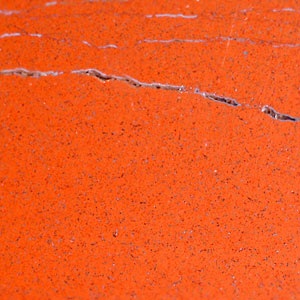 |
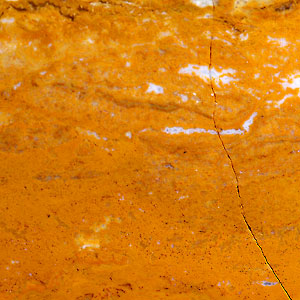 |
| Red Jasper with small crack |
Yellow jasper with crack and healed fissures containing chalcedony. |
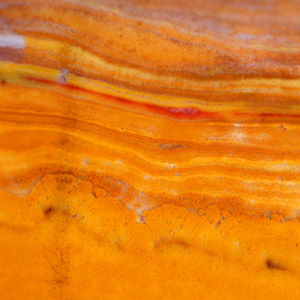 |
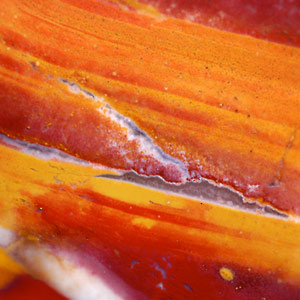 |
| Jasper showing bedding lines |
Jasper showing bedding lines and void filled with chalcedony & quartz. |
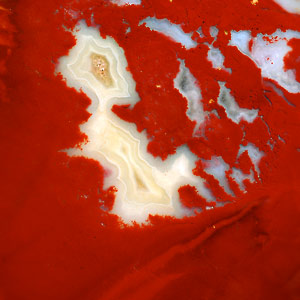 |
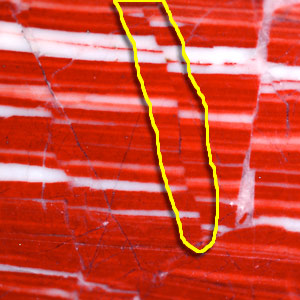 |
| Fine grained red jasper with agate fill in void spaces. |
Bedding layers are easily visible, and you can see a "fault" line that offset the layers after the jasper was formed. |
Another type of jasper pattern is caused when the jasper has formed, and it is located near tectonically active areas. Faulting may break up the jasper into irregular pieces, and then more silica solution re-cements the pieces together forming a solid rock again. One of the more famous varieties in Stone Canyon jasper for California.
Another interesting material is called chapenite, and comes from California. It appears to be a brecciated jasper in the center of irregular nodules. The centers of the nodules show strong brecciation, but are sometime completely wrapped in unbroken chalcedony. The material may have been broken by one tectonic event then re-cemented, and then broken by a larger event and somehow sorted. Sorted here refers to the process of either stream movement or landslide. The brecciated fragments were worn, then redistributed and finally cemented again. I don't think anyone knows for certain their complete genesis
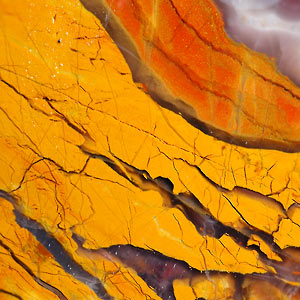 |
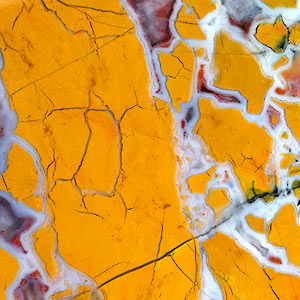 |
| Typical tone Canyon jasper with "healed" cracks. |
Stone Canyon jasper with healed cracks, then secondary re-cracking and healing. |
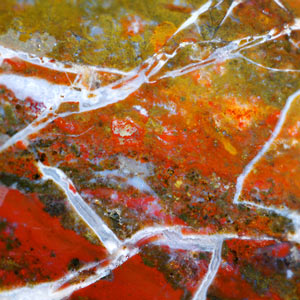 |
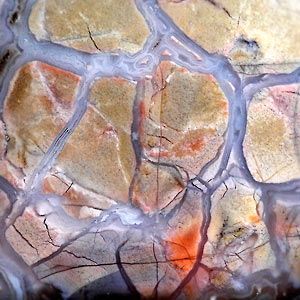 |
| A Brazilian jasper (amazon jasper) that shows signs of brecciation. |
The interior of a chapenite nodule from California. The re-gluing process has formed fortification agate in many of the channels. |
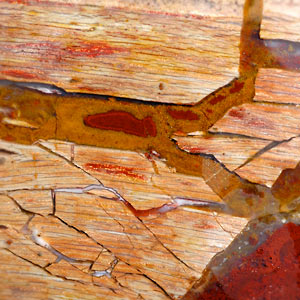 |
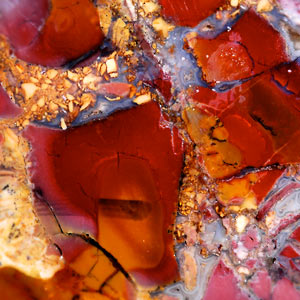 |
| In this example a piece of petrified wood was trapped in the sediment and brecciated along with the jasper, then re-cemented. |
Here a red jasper is broken up, but secondary stones in the sediment are also broken in the brecciation process. |
Orbicular jasper has patterns of circles, ovals, or egg-like shapes, or collectively they are "orbs". Some of the best orb jaspers were from the ones from the American northwest, Breneau, and may of the picture jaspers (e.g. Willow Creek, Imperial, and Biggs) contained the large egg-like features and were highly sought. California and Mexico produce a variety of what is known as Poppy Jasper with concentric circles often in earth tones, reds and yellow. More recently and currently the best known orb jaspers are coming from Madagascar, Kambaba and Ocean Jasper. The Ocean Jasper often displays nearly perfect circles and the chalcedony can be translucent to nearly transparent.
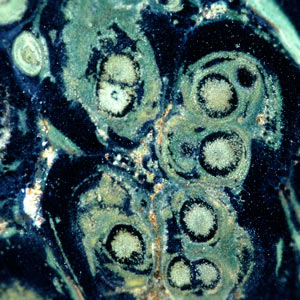 |
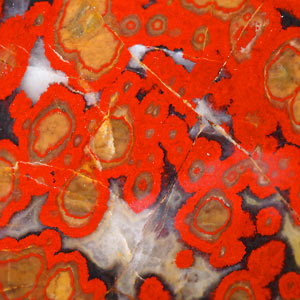 |
|
Kambaba Jasper
|
Poppy Jasper
|
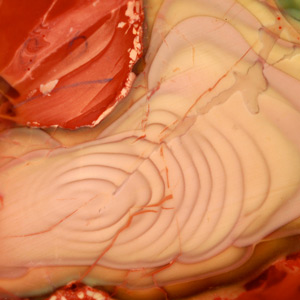 |
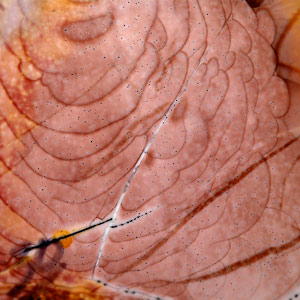 |
|
Willow Creek Jasper
|
Willow Creek Jasper
|
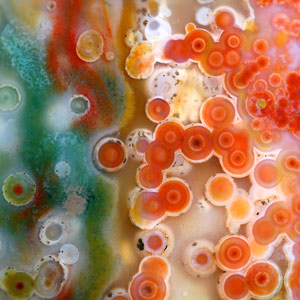 |
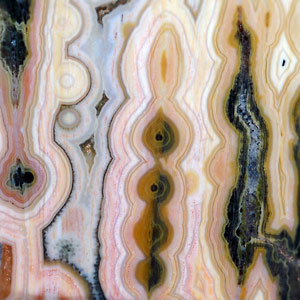 |
|
Ocean Jasper
|
Ocean Jasper
|
Scenic jasper get their name from their patterning that evokes picture-like scenes often of the American Southwest or other desert environments.. The resultant images may contain tree or plant-like structures (dendrites), depict valleys, water, sky, mountains, caves, sand dunes, or even ocean waves. The images produced are often one of a kind, and purely found by luck. (The luck of how a diamond saw passed through the interior of the jasper to produce any given slab.) Sometimes the pictures are too large to cut into jewelry and they are polished and framed as small painting.
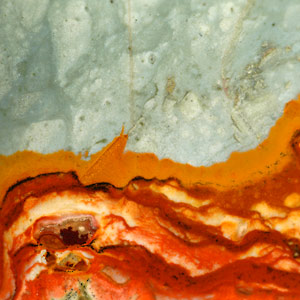 |
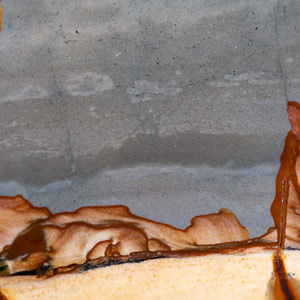 |
|
Rocky Butte Jasper
|
Biggs Jasper
|
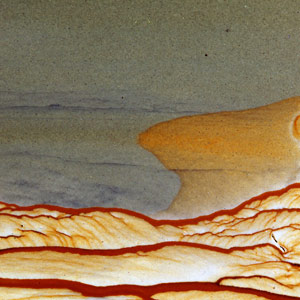 |
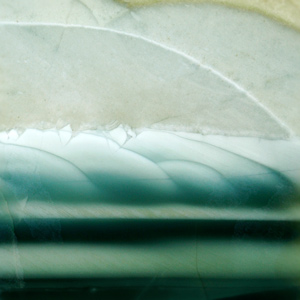 |
|
Deschutte Jasper
|
Imperial Jasper
|
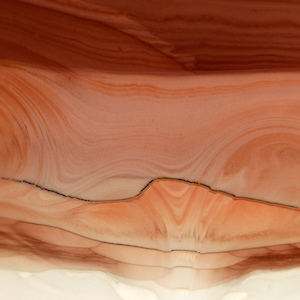 |
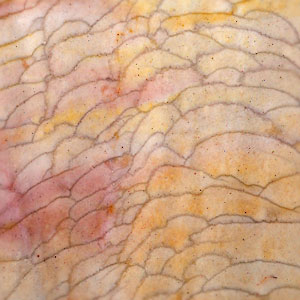 |
|
Willow Creek Jasper
|
Misty Mountain Jasper
|
There are many unique patterns in jasper form all around the world. New ones appear every year. The patterns are often snap-shots of the sedimentary process used in creating the initial clays, sandstones, mudstone or siltstones. Colors run throughout the spectrum and combinations too are many and varied. Below are some more examples of structures and colors in my collection.
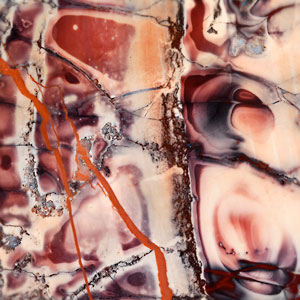 |
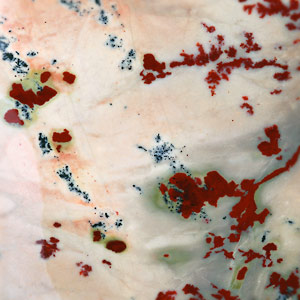 |
|
SciFi Jasper (aka. porcelain jasper or exotica jasper or santefe jasper or ???)
|
Chinese Dendritic Jasper
(aka Owyhee Flower Jasper)
|
|
|
|
|
Fantasy Jasper
|
Belvade Jasper
|
|
|
|
|
Owyhee Cherry Creek Jasper
|
Mookaite Jasper
|
|
|
|
|
Carrasite Jasper
|
Mushroom Jasper
|
Jasper tends to be my favorite materials to cut as they tend to have uniform textures and few soft or weak areas. Enjoy the examples above and then look at the selection of finished stones on their individual pages.
|

